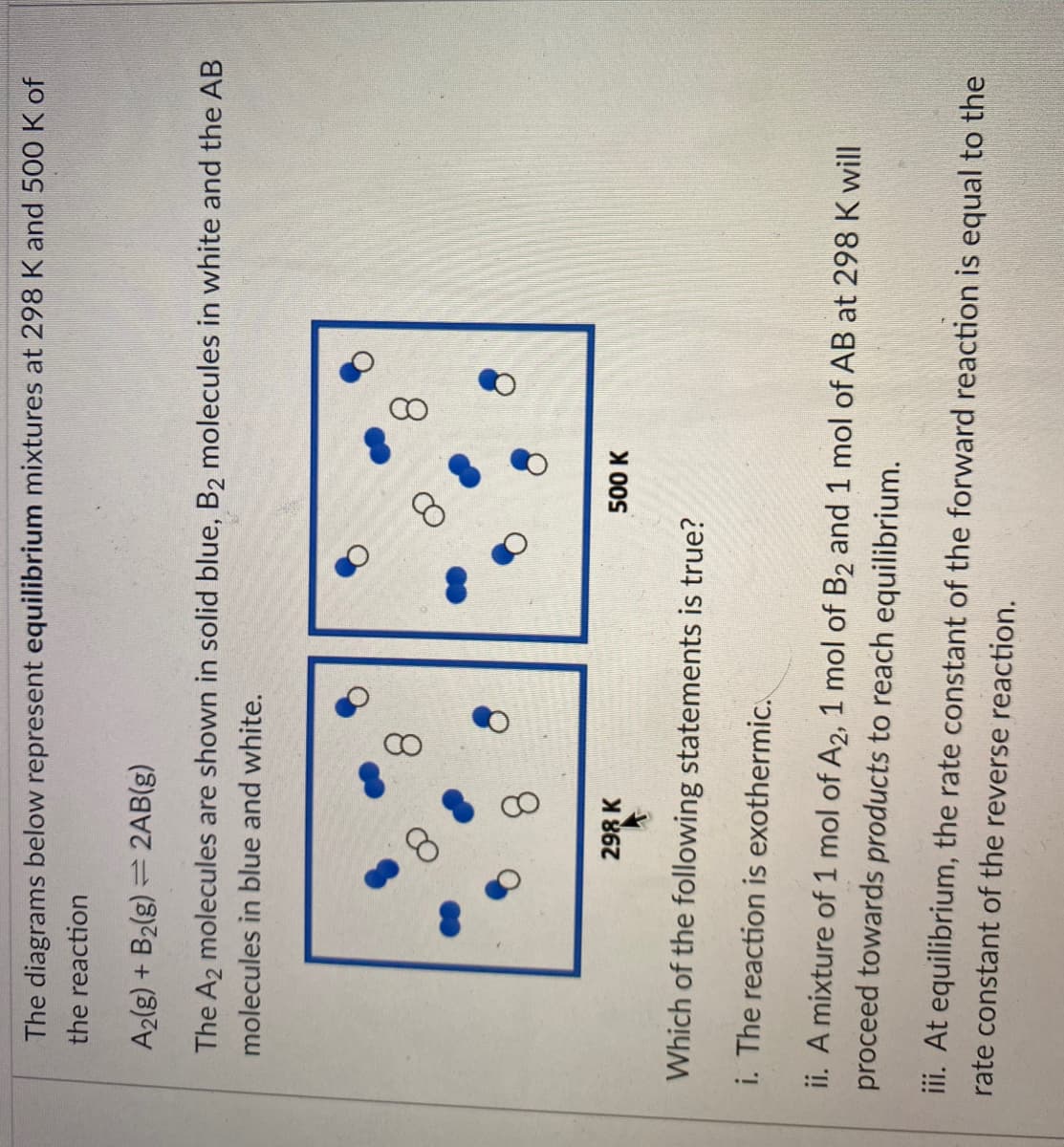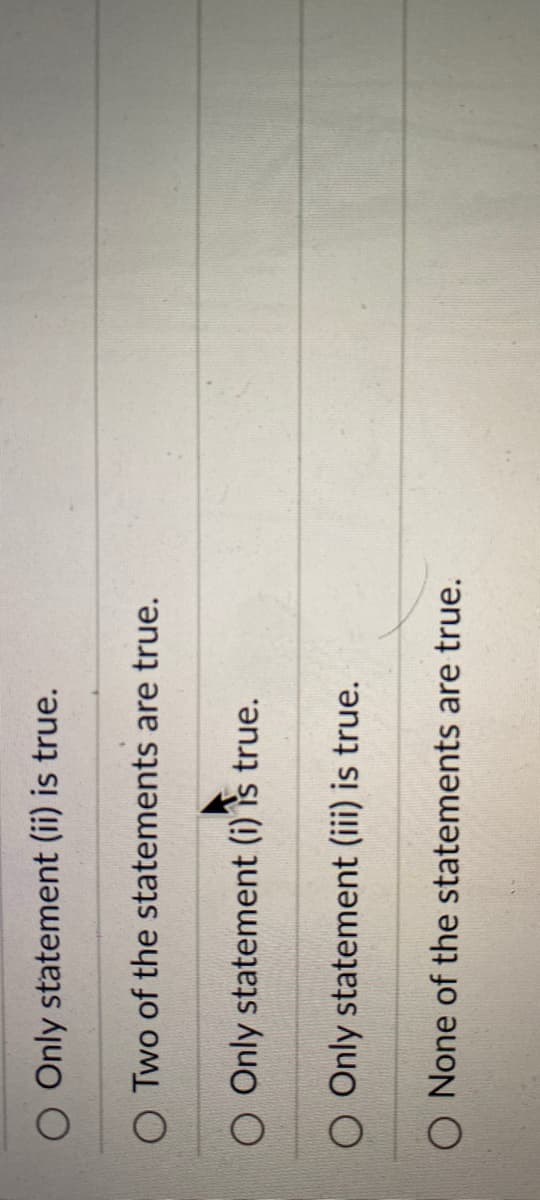8 The diagrams below represent equilibrium mixtures at 298 K and 500 K of the reaction A2(g) + B2(g) = = 2AB(g) The A2 molecules are shown in solid blue, B2 molecules in white and the AB molecules in blue and white. 8. 8. 8. 298 K 500 K Which of the following statements is true? i. The reaction is exothermic. ii. A mixture of 1 mol of A2, 1 mol of B2 and 1 mol of AB at 298 K will proceed towards products to reach equilibrium. iii. At equilibrium, the rate constant of the forward reaction is equal to the rate constant of the reverse reaction.
8 The diagrams below represent equilibrium mixtures at 298 K and 500 K of the reaction A2(g) + B2(g) = = 2AB(g) The A2 molecules are shown in solid blue, B2 molecules in white and the AB molecules in blue and white. 8. 8. 8. 298 K 500 K Which of the following statements is true? i. The reaction is exothermic. ii. A mixture of 1 mol of A2, 1 mol of B2 and 1 mol of AB at 298 K will proceed towards products to reach equilibrium. iii. At equilibrium, the rate constant of the forward reaction is equal to the rate constant of the reverse reaction.
Principles of Modern Chemistry
8th Edition
ISBN:9781305079113
Author:David W. Oxtoby, H. Pat Gillis, Laurie J. Butler
Publisher:David W. Oxtoby, H. Pat Gillis, Laurie J. Butler
Chapter13: Spontaneous Processes And Thermodynamic Equilibrium
Section: Chapter Questions
Problem 7P
Related questions
Question

Transcribed Image Text:8.
The diagrams below represent equilibrium mixtures at 298 K and 500 K of
the reaction
A2(g) + B2(g) = 2AB(g)
The A2 molecules are shown in solid blue, B2 molecules in white and the AB
molecules in blue and white.
8.
8.
8.
298 K
500 K
Which of the following statements is true?
i. The reaction is exothermic.
ii. A mixture of 1 mol of A2, 1 mol of B2 and 1 mol of AB at 298 K will
proceed towards products to reach equilibrium.
iii. At equilibrium, the rate constant of the forward reaction is equal to the
rate constant of the reverse reaction.

Transcribed Image Text:O Only statement (ii) is true.
O Two of the statements are true.
O Only statement (i) is true.
O Only statement (iii) is true.
O None of the statements are true.
Expert Solution
This question has been solved!
Explore an expertly crafted, step-by-step solution for a thorough understanding of key concepts.
This is a popular solution!
Trending now
This is a popular solution!
Step by step
Solved in 4 steps

Knowledge Booster
Learn more about
Need a deep-dive on the concept behind this application? Look no further. Learn more about this topic, chemistry and related others by exploring similar questions and additional content below.Recommended textbooks for you

Principles of Modern Chemistry
Chemistry
ISBN:
9781305079113
Author:
David W. Oxtoby, H. Pat Gillis, Laurie J. Butler
Publisher:
Cengage Learning

Chemistry for Engineering Students
Chemistry
ISBN:
9781337398909
Author:
Lawrence S. Brown, Tom Holme
Publisher:
Cengage Learning

Chemistry
Chemistry
ISBN:
9781305957404
Author:
Steven S. Zumdahl, Susan A. Zumdahl, Donald J. DeCoste
Publisher:
Cengage Learning

Principles of Modern Chemistry
Chemistry
ISBN:
9781305079113
Author:
David W. Oxtoby, H. Pat Gillis, Laurie J. Butler
Publisher:
Cengage Learning

Chemistry for Engineering Students
Chemistry
ISBN:
9781337398909
Author:
Lawrence S. Brown, Tom Holme
Publisher:
Cengage Learning

Chemistry
Chemistry
ISBN:
9781305957404
Author:
Steven S. Zumdahl, Susan A. Zumdahl, Donald J. DeCoste
Publisher:
Cengage Learning

Chemistry: An Atoms First Approach
Chemistry
ISBN:
9781305079243
Author:
Steven S. Zumdahl, Susan A. Zumdahl
Publisher:
Cengage Learning


Introductory Chemistry: A Foundation
Chemistry
ISBN:
9781337399425
Author:
Steven S. Zumdahl, Donald J. DeCoste
Publisher:
Cengage Learning